Spider-view: "Return to the Mad Dog Ward"
A singular spectacular moment shines in an otherwise lackluster sequel to Ann Nocenti's original crossover arc
—by Nathan on February 2, 2025—
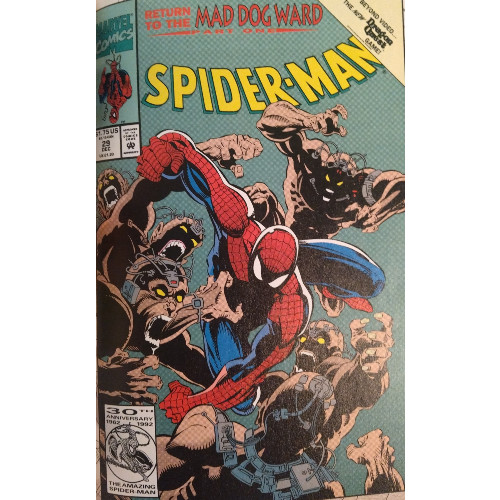
In 1987, writer Ann Nocenti gave readers a little arc called "Life in the Mad Dog Ward," a three-part story arc that crossed over Amazing Spider-Man, Peter Parker, the Spectacular Spider-Man, and Web of Spider-Man. Published directly after J.M. DeMatteis and Mike Zeck's "Kraven's Last Hunt," the narrative did little, in my opinion, to dovetail with such an exceptionally written and horrifyingly impactful narrative. Though an original narrative in its own right striving to do something different with Peter–throwing him in with an eclectic group of patients suffering from different mental disorders–the story wavered between Peter and another central character, the division not adequately plumbed given the narrative's brief nature. Fortunately, as a brief aside, DeMatteis and Zeck would return to provide some closure on their (in)famous arc.
Five years later, Nocenti made her own return, dropping into the adjectiveless Spider-Man series to follow up on her narrative with another three-parter. No longer the baby of series creator Todd McFarlane, Spider-Man had pivoted away from his vision, usurped by others. I don't know enough of the title's history to know when it moved away from "stories executed by specific creators" to meld in with Amazing, Spectacular, and Web to become "just another Spider-Man series." I'd argue Erik Larson's "Revenge of the Sinister Six" maintained a higher level of quality, but here…? Does Nocenti's (and Peter's) return to a prior narrative facilitate the higher quality the adjectiveless Spider-Man originally promised?
"Return to the Mad Dog Ward"
Writer: Ann Nocenti
Penciler: Chris Marrinan
Inkers: Sam de la Rosa, Don Hudson
Colorists: Marie Javins, Kevin Tinsley
Letterer: Chris Eliopoulos
Issues: Spider-Man #29-31
Publication Dates: December 1992-February 1993
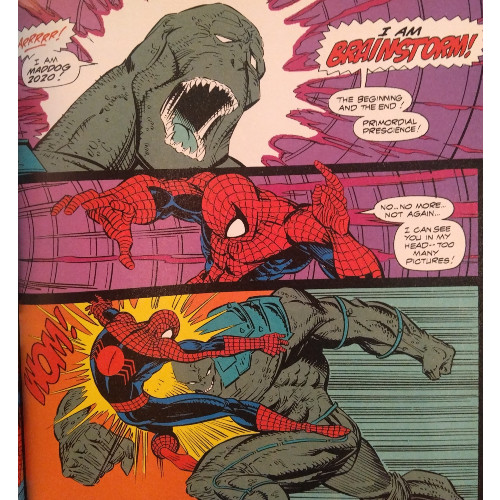
To Nocenti's credit, "Return to the Mad Dog Ward" feels like it's trying to build upon its predecessor. In Nocenti's original tale, Spidey found himself a patient in the Mad Dog Ward in a mob-run clinic after a failed attempt to save the mother of two young children. Spidey would eventually escape his confinement with the help of other patients, including the childlike but superstrong Zero, and fighting the superhuman Brainstorm, an experiment of the villainous scientist running the clinic.
Nocenti's follow up involves the principle characters first encountered in the original "Mad Dog Ward"–the brave Zero takes steps at becoming a gen-u-wine superhero, complete with codename (it's now "Captain Zero" to you, mister) and costume; Brainstorm has undergone a horrifying physical transformation which makes him the most reptilian rapscallion Spidey's faced since his last tussle with the Lizard; Dr. Hope…well, the not-so-good doctor lingers in the background, faking insanity to covertly further his own insidious ends.
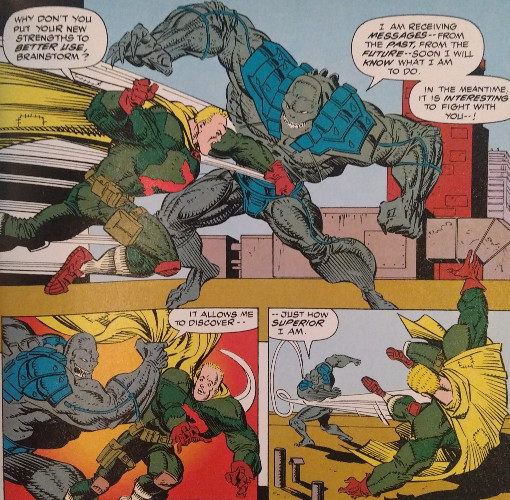
I never felt like the original "Mad Dog Ward" needed much of a continuation, and Nocenti doesn't do much to justify the return of the characters she created. I wound up rather surprised by the general quality, especially as I'm concurrently reading through (and enjoying) the first issues which formed her acclaimed run on Daredevil. In the wake of Frank Miller's "Born Again," the title bounced around a couple of writers, with Nocenti clawing her way to the top spot on the back of, what I would argue, were quality stories, especially in comparison to her compatriots. I intend to review the volume I'm reading later, so that's all I'll say about Daredevil. I suppose even good writers are allowed their misfires, and this is one of Nocenti's.
She strives to develop a narrative which satisfyingly provides closure to the original story, but again, the counterargument I found myself putting forth as I read was that we never needed any closure to begin with. Little is done to make me care about the future of a character like Zero, whose simple yet endearing early efforts at superheroing are cast as stepping stones to a larger superhero career. Spidey is cast in the role of mentor (as other writers have done), and while I admire the big brother/little brother aspects Nocenti tries to inject into the relationship between Spidey and Zero, the concept is muted given Zero's complete absence from future Spidey stories. He never appears after this. If you're looking for a better "big lug who serves as a Superman knockoff Spidey takes under his wing," may I suggest Ethan Edwards?
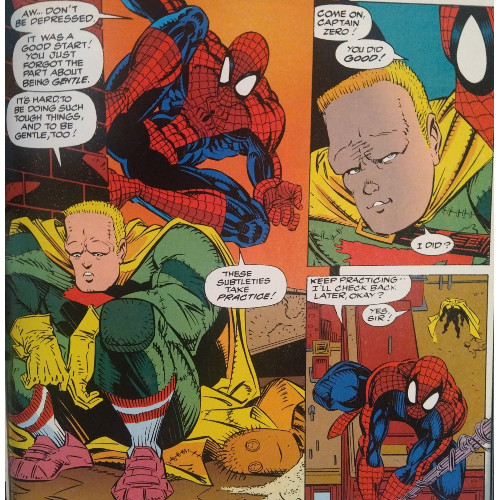
What also rankles my own "Spidey-senses" is the Web-Head's treatment of Zero. Yes, there is that brotherly aspect–Spidey, to a certain extent, feels responsible for Zero's training–but Peter comes across as overbearing to the point of being cruel. Later in the narrative, we get more of a bond between Spidey and Zero, but in their initial encounters, Spidey browbeats the poor dude. Little is made to suggest that Nocenti is having Spidey go too far verbally–there's a confident insistence in his words that leads us (or at least me) to perceive Spidey's barrage of admonishment as genuine. Heroes these days have to be tough, y'know, and though I'm not really aware of how much "rough'n'tumble" Nocenti injected into Daredevil's world, that same formula doesn't work as well on the Spidey side of New York. Tonally, this subplot is a mess.
Also messy is Nocenti's portrayal of MJ, who begins, oddly enough, in an interesting place. Tired of all the cheesy romance parts she receives, MJ hopes to land stronger roles, something other than a main character's love interest. Conceptually, the subplot serves as a commentary on MJ's own relationship with Peter, her feelings of being typecast in shows akin to feeling typecast as a superhero's wife. She experiences a lack of control and hopes to reclaim some agency…an idea which is completely sidelined when Peter begins working with a female coworker. Spotting the pair, MJ immediately hypothesizes infidelity, keeping her suspicions to herself and reacting just as strongly to her own fears as Peter does to Zero's limited progress.
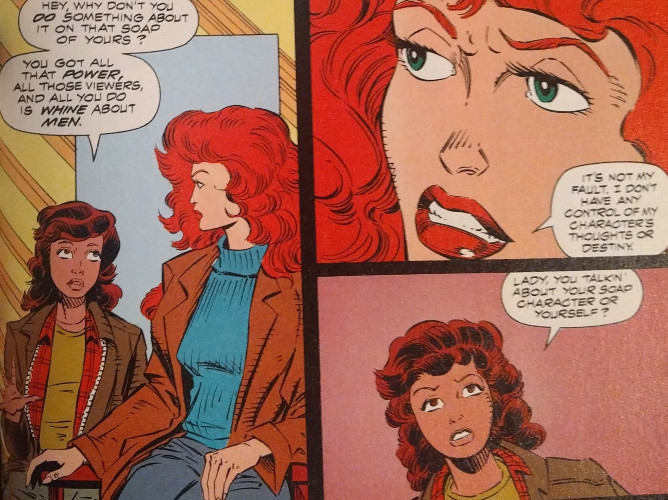
MJ does experience an outward focus herself–much like Spidey mentors Peter, MJ aids a young boy in finding a real father. There is a sense Nocenti is attempting to achieve a type of balance through this thread, that these different pieces constitute a change in MJ's perspective of herself and her situation. Perhaps fearing Peter's unfaithfulness leads her to a greater confidence in herself; perhaps aiding the young boy works to show MJ she doesn't always need to be reliant on Peter. Whatever the concept driving MJ, she develops a slight defiance by the narrative's end, but this is muddled by the worrying and the rather extraneous subplot involving the orphaned boy. It's the old "We need MJ to do something while Spidey fights crime" syndrome plaguing other narratives. My interest, I think, would not have sullied were MJ given a single direction, but Nocenti heaps on these narrative pieces–Peter's possible infidelity! An orphaned boy! Typecast TV roles!–that they all jumble together instead of reinforcing each other. The base idea is there, but the execution is clumsy.
What isn't clumsy is a standout sequence Nocenti and penciler Chris Marrinan develop in the third chapter. During his first fight with Brainstorm, Spidey is knocked into a cement mixer and subsequently dumped deep into the foundation of a building site. This leads to a wonderful string of images from Marrinan as Spidey finds himself embedded in the hardening concrete and valiantly struggles to claw his way out, fighting dark, depressing thoughts the entire time. I'm genuinely amazed that this moment isn't mentioned on lists about Spidey's most harrowing feats. Whereas the rest of the story is a mess, here art and narration click as Spidey digs himself, hand over hand, through the cement.
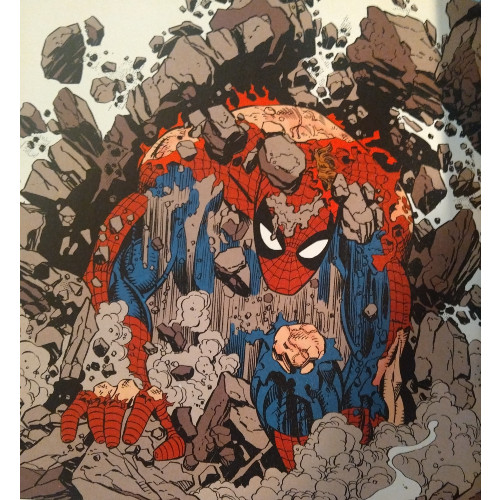
Some may compare this moment to other struggles Spidey's endured–such as straining against the weight of collapsed metal supports in the classic ASM #33 ("The Final Chapter" in the "If This Be My Destiny" arc) or digging himself out of his grave during "Kraven's Last Hunt." Certainly, the parallels between this moment and "Last Hunt" are obvious, and I wonder if those comparisons have led to this moment being, if you'll pardon the expression, buried. But honestly? For all its misfires, "Return to the Mad Dog Ward" challenges"“Last Hunt" for the sheer tension and claustrophobia it creates. You feel the despair Spidey endures as he agonizingly moves, inch by inch and fist over fist. Marrinan's pencils, though just entertaining through the rest of the story, work overtime in a panel where Spidey finally bursts free of his concrete tomb. The half-page image of Spidey breaking through the slab, his costume in shambles, pieces of concrete cascading around him, dust kicking up all around, might just cement itself (yeah, yeah, I said it) as one of the single best panels I've seen in a Spidey comic.
Credit must be given where credit is due. What comes before and after this spectacular feat of strength is lackluster, and that isn't even by comparison. The rest of the story doesn't tread any new ground, add any new depth or dimensions to characters, and relies on some of the cheesy, soap opera elements that MJ herself derides early in the story. The pieces that are supposed to read encouragingly–Zero becoming a hero, MJ becoming her own person–instead feel cheap and unearned. Fortunately, Nocenti and Marrinan deliver one heck of a third act as Spidey breaks through the concrete. For a single panel, this story becomes more than forgettable, which is good. That image will probably be the only part of this tale that sticks in my brain. Though Spidey breaks free of a concrete tomb, he cannot pull this story up with him. I think we can all pass on a third trip to the Mad Dog Ward.